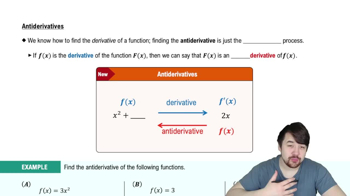Find a particular solution to the differential equation , given that .
Table of contents
- 0. Functions7h 54m
- Introduction to Functions16m
- Piecewise Functions10m
- Properties of Functions9m
- Common Functions1h 8m
- Transformations5m
- Combining Functions27m
- Exponent rules32m
- Exponential Functions28m
- Logarithmic Functions24m
- Properties of Logarithms36m
- Exponential & Logarithmic Equations35m
- Introduction to Trigonometric Functions38m
- Graphs of Trigonometric Functions44m
- Trigonometric Identities47m
- Inverse Trigonometric Functions48m
- 1. Limits and Continuity2h 2m
- 2. Intro to Derivatives1h 33m
- 3. Techniques of Differentiation3h 18m
- 4. Applications of Derivatives2h 38m
- 5. Graphical Applications of Derivatives6h 2m
- 6. Derivatives of Inverse, Exponential, & Logarithmic Functions2h 37m
- 7. Antiderivatives & Indefinite Integrals1h 26m
- 8. Definite Integrals4h 44m
- 9. Graphical Applications of Integrals2h 27m
- 10. Physics Applications of Integrals 3h 16m
- 11. Integrals of Inverse, Exponential, & Logarithmic Functions2h 34m
- 12. Techniques of Integration7h 41m
- 13. Intro to Differential Equations2h 55m
- 14. Sequences & Series5h 36m
- 15. Power Series2h 19m
- 16. Parametric Equations & Polar Coordinates7h 58m
7. Antiderivatives & Indefinite Integrals
Antiderivatives
Problem 4.9.5
Textbook Question
Give the antiderivatives of xᵖ . For what values of p does your answer apply?
 Verified step by step guidance
Verified step by step guidance1
Step 1: Recall the general formula for the antiderivative of a power function xᵖ. The antiderivative of xᵖ is given by: ∫xᵖ dx = (1/(p+1)) * x^(p+1) + C, where C is the constant of integration.
Step 2: Identify the condition under which this formula is valid. The formula applies when p ≠ -1, because dividing by (p+1) would result in division by zero if p = -1.
Step 3: For the special case where p = -1, the antiderivative of x⁻¹ is ∫x⁻¹ dx = ∫(1/x) dx = ln|x| + C. This is derived from the natural logarithm function.
Step 4: Summarize the result. The antiderivative of xᵖ is (1/(p+1)) * x^(p+1) + C for p ≠ -1, and ln|x| + C for p = -1.
Step 5: Ensure clarity by emphasizing that the constant of integration, C, must always be included in the final expression for the antiderivative.
 Verified video answer for a similar problem:
Verified video answer for a similar problem:This video solution was recommended by our tutors as helpful for the problem above
Video duration:
4mPlay a video:
Was this helpful?
Key Concepts
Here are the essential concepts you must grasp in order to answer the question correctly.
Antiderivative
An antiderivative of a function is another function whose derivative is the original function. In calculus, finding the antiderivative is a fundamental operation, often referred to as integration. For example, the antiderivative of x^p is (x^(p+1))/(p+1), provided p is not equal to -1.
Recommended video:

Antiderivatives
Power Rule for Integration
The Power Rule for Integration states that the integral of x raised to a power p is given by (x^(p+1))/(p+1) + C, where C is the constant of integration. This rule applies when p is not equal to -1, as the case p = -1 leads to the natural logarithm function, ln|x|, instead.
Recommended video:

Power Rule for Indefinite Integrals
Domain of the Antiderivative
The domain of the antiderivative refers to the values of p for which the antiderivative formula is valid. Specifically, the formula (x^(p+1))/(p+1) applies for all real numbers p except p = -1, where the function x^p becomes x^(-1) and its antiderivative is ln|x|, indicating a different behavior at that point.
Recommended video:

Antiderivatives
Related Videos
Related Practice
Multiple Choice
51
views


